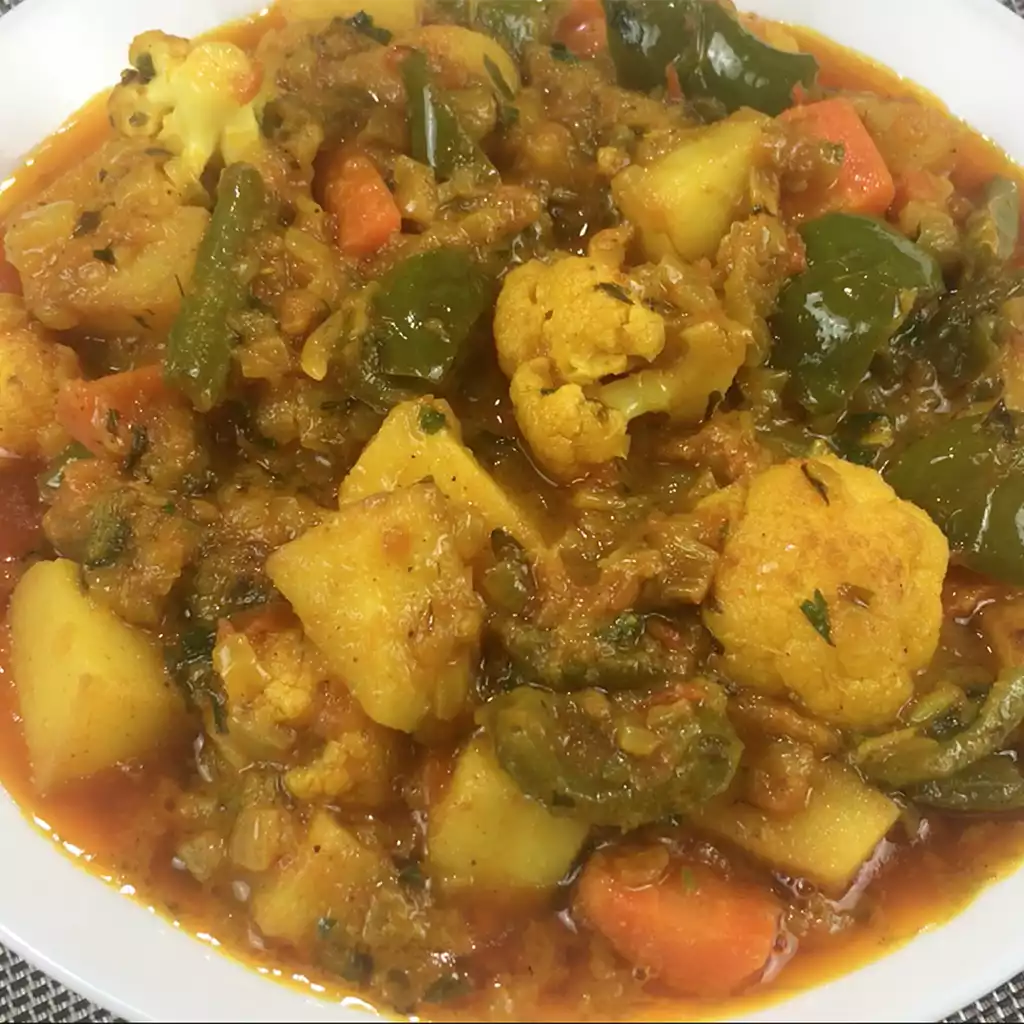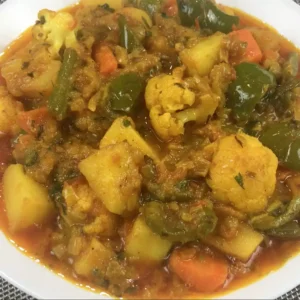
In the heart of every home cook’s repertoire lies the timeless delight of Vegetable Curry. This aromatic dish, originating from the colorful tapestry of Indian cuisine, offers a symphony of flavors and textures that dance on your palate.
Despite its exotic origins, its preparation is remarkably approachable, making it an ideal choice for both novice and seasoned cooks alike.
With a medley of fresh vegetables infused with fragrant spices, Vegetable Curry brings together the wholesome goodness of nature’s bounty with the warmth of traditional Indian seasonings.
From the earthy notes of potatoes and cauliflower to the vibrant hues of bell peppers and carrots, each ingredient plays a pivotal role in creating a dish that bursts with both flavor and nutrition.
Though its roots may lie in the rich culinary heritage of the Indian subcontinent, Vegetable Curry knows no bounds, finding its way into kitchens and hearts around the world.
Expert Tip: When adding the spices to the onions and tomatoes, take your time to cook them thoroughly.
Vegetable oil: Provides the base for cooking and helps to evenly distribute heat throughout the pan. It adds richness to the dish while allowing the spices to bloom and flavors to meld.
Cauliflower (Gobi): Adds a delightful crunch and subtle sweetness to the curry. Its mild flavor complements the other vegetables and absorbs the aromatic spices beautifully.
Potatoes (Aloo): Bring a comforting creaminess to the dish while offering a hearty texture. They act as a natural thickener, enhancing the curry’s consistency.
Bell Pepper: Infuses the curry with a burst of color and a hint of sweetness. Its crispness adds a refreshing contrast to the softer vegetables.
Green Beans: Contribute a satisfying crunch and vibrant green color to the curry. They bring a freshness that balances the rich flavors of the spices.
Carrot: Provides natural sweetness and a tender texture to the curry. Its bright orange hue adds visual appeal to the dish.
Onion: Forms the flavor base of the curry, lending a savory depth and sweetness when cooked down. It adds richness and complexity to the overall flavor profile.
Tomatoes: Offer a tangy acidity and a luscious juiciness to the curry. They help to balance the spices and enhance the overall umami flavor.
Garlic Paste: Infuses the curry with pungent flavor and aroma. It adds depth and complexity to the dish, enhancing its savory notes.
Ginger Paste: Provides warmth and a hint of spiciness to the curry. It pairs perfectly with the other spices, adding a zesty kick to the dish.
Salt: Enhances the natural flavors of the vegetables and spices, ensuring a well-balanced taste.
Chilli Powder: Adds a fiery kick to the curry, imparting heat and depth of flavor. Adjust according to your spice tolerance for a dish that suits your taste.
Turmeric Powder (Haldi): Lends a vibrant yellow hue to the curry and offers earthy undertones. It also boasts anti-inflammatory properties, making the dish both flavorful and healthful.
Cumin Powder: Provides a warm, smoky flavor and a subtle hint of bitterness to the curry. It enhances the overall complexity of the spice blend.
Garam Masala: A fragrant blend of spices that adds warmth and depth to the curry. It typically includes cinnamon, cardamom, cloves, and other aromatic spices, imparting a rich and complex flavor.
Coriander Powder: Offers a fresh, citrusy flavor with hints of warmth and sweetness. It complements the other spices and adds a refreshing herbal note to the curry.
Dried Fenugreek Leaves (Methi): Contribute a unique, slightly bitter flavor and a subtle aroma to the curry. They add depth and complexity to the dish, enhancing its overall taste.
Coriander: Fresh coriander leaves, also known as cilantro, provide a bright and herbaceous finish to the curry. They add a burst of freshness and color, elevating the dish to new heights.
Expert Tip: The key to a delicious Vegetable Curry lies in using fresh, high-quality ingredients.
Expert Tip: Adjust the amount of chili powder according to your taste preferences.
Absolutely! One of the beauties of Vegetable Curry is its versatility. Feel free to experiment with your favorite vegetables or whatever you have on hand. Some great options include spinach, peas, broccoli, or even mushrooms.
The level of spiciness can be adjusted to suit your taste preferences. If you prefer a milder curry, you can reduce the amount of chili powder or omit it altogether. Conversely, if you like it extra spicy, feel free to increase the amount of chili powder or add fresh chili peppers.
Yes, Vegetable Curry actually tastes even better the next day as the flavors have had time to meld together. You can make it ahead of time and store it in the refrigerator for up to 3-4 days. Simply reheat it on the stove or in the microwave before serving.
Yes, this Vegetable Curry recipe is entirely vegan and vegetarian-friendly. It contains no animal products, making it suitable for those following a plant-based diet.
Absolutely! Vegetable Curry freezes exceptionally well. Once cooled, transfer any leftovers to an airtight container and freeze for up to 3 months. To reheat, simply thaw overnight in the refrigerator and then reheat on the stove or in the microwave until heated through.
If you prefer a creamier curry, you can add a splash of coconut milk or cashew cream towards the end of cooking. This will not only add richness but also lend a luxurious creaminess to the curry.
In addition to rice or naan, Vegetable Curry pairs well with other Indian side dishes such as samosas, pakoras, or papadums. You can also serve it alongside a variety of chutneys, pickles, and yogurt-based dips for added flavor and texture.
To make this curry gluten-free, simply ensure that the spices you use are certified gluten-free. Additionally, you can substitute any wheat-based ingredients such as naan with gluten-free alternatives like rice or quinoa.
Leftover Vegetable Curry can be stored in an airtight container in the refrigerator for up to 3-4 days. Be sure to allow it to cool completely before refrigerating to prevent bacterial growth.
Here are some more recipes for you to enjoy! If you my recipes don’t forget to rate and leave a comment.
If you have any recipe suggestions, please do not hesitate to ask me. A great way to stay in contact with me is through Instagram, Facebook, Twitter and YouTube. Don’t forget to tag me @CookwithNabeela in your recipe photos!

Subscribe now to receive my latest recipes directly in your inbox. Stay up-to-date and never miss out!

I love to cook! I want to share with you my favourite, delicious family-friendly recipes. I want to inspire you to create fantastic food for your family every day.
Latest comments (24)
This is the best vegetable curry I’ve had since Nairobi! So good. Thank you for the recipe. It was easy to make and I followed your directions exactly and we just can’t get enough. Cheers!
That means a lot! So glad you all enjoyed it. Thanks for giving it a go! 😊
Absolutely fabulous.. I batch cook this and have it lunchtimes when working from home, just do a quick few chapatis to cook and lunch is served !